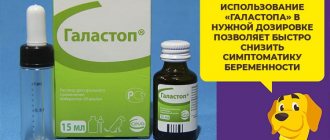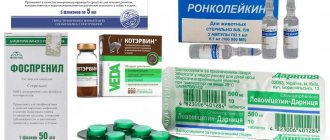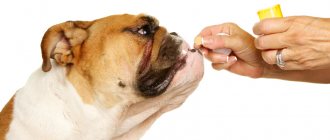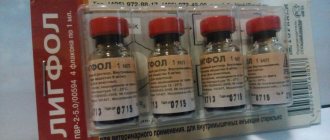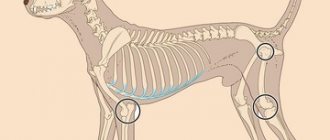The topic of dog castration is the most popular among breeders. The purpose of this procedure is to deprive the animal of sexual function by surgically removing the gonads or stopping their work. Most often, removal is carried out through surgery, in rare cases using chemicals. Castration can be carried out on both the cable and the bitch. During the procedure, the dog’s testicle or ovaries and uterus are removed, as a result of which it is simply impossible to restore the animal’s reproductive function. Chemical castration of dogs and cats is not performed very often. This procedure can be performed on a dog aged 6 to 12 months, but it costs much more than surgical castration, and also has some contraindications and possible complications.
Differences between castration
It is important to consider all the pros and cons of types and methods of sterilizing dogs. In scientific language, castration and sterilization are two identical concepts, but many veterinarians have different meanings when communicating with clients. Castration, as a rule, is the complete removal of an animal's gonads (testes) in cables and the uterus and ovaries in females.
Sterilization is a procedure in which only the appendages are removed. The choice of therapy will directly depend on the owner’s goals, but castration is used most often, since after the complete removal of the ovaries, the uterus ceases to perform functions and atrophies after a couple of months.
Why is it carried out?
Castration is a popular procedure among dog breeders, as well as ordinary animal owners. The opinions of veterinarians about the obligatory nature of such an operation are constantly changing. But the owners decide to carry it out for the following reasons:
- the presence of serious tumors in the dog’s prostate gland;
- aggressiveness and irritability of the animal due to excessive amounts of testosterone in the body;
- malignant tumors in the ovaries;
- problems with the functioning of the hormonal system;
- unilateral or bilateral cryptorchidism;
- the owner’s reluctance for the dog to take part in breeding;
- pyometra;
- false conception with complications;
- the presence of malignant tumors in the uterus and ovaries;
- to prevent the development of diseases of the genitourinary system.
In most cases, after castration, the animal’s behavior changes greatly. If everything is quite simple with the physiological state, then the behavioral factor remains ambiguous. Most often, males and females do not become more friendly, they only develop inhibition processes. Fear leads to the appearance of a dangerous type of aggression, which is no longer associated with an excessive amount of hormones in the animal’s body, so removal of the testicles does not affect it in any way.
In this case, the animal almost does not change its behavior. A completely different thing happens with attraction to the opposite sex; after the operation, the animal stops running away to females in heat, will be less likely to get into fights with other cats and show its dominance.
It should be noted that the dog does not stop marking the territory after sterilization; cables have such a habit at a natural level.
Many males over the age of 6 years suffer from prostatitis, and about 60% of females after 6-7 years of life are diagnosed with benign and malignant formations in the appendages and mammary glands. Cryptorchid (when one or two testicles do not descend into the scrotum of a newborn male after 2-3 months of life) suffer from inflammatory processes and neoplasms in the body. Sterilization of the animal in this case helps prevent the occurrence of these problems and maintain the health of the pet.
How Suprelorin works - in simple words
Gonadotropin is not a sex hormone; it is one level higher. This is why Suprelorin causes temporary sterilization in both males and females. To understand this mechanism, let's look at how sexual function is regulated in dogs.
All hormones in the body are controlled by the pituitary gland, a gland in the brain. And the pituitary gland, in turn, obeys the hypothalamus. It is the hypothalamus that produces gonadotropin-releasing hormone (GnRH). GnRH instructs the pituitary gland to produce follicle-stimulating and luteinizing hormones (FSH and LH). And they already affect the sex glands.
In males, LH causes the production of testosterone, and FSH stimulates the production of sperm in the testes.
The active ingredient in Suprelorin, deslorelin, is a synthetic GnRH agonist. Deslorelin acts on the pituitary gland by blocking its receptors for the effects of GnRH. The synthetic hormone is much more active than the natural one, therefore, when Suprelorin is first administered, a rapid release of LH and FSH occurs, and testosterone levels increase.
We recommend reading: How to feed newborn kittens without a cat or a puppy without a mother dog. Caring for a kitten and puppy, options for feeding mixtures.
After a short period (1-2 weeks) of stimulation, the production of LH and FSH in the pituitary gland stops, and the testes are no longer commanded to produce sperm and testosterone. Over time, the testicles decrease in size by 2-3 times.
And now again - with pictures:
Testosterone levels decrease gradually. A male dog is considered capable of breeding within 6 weeks after the first administration of Suprelorin. After 1.5 months, even being kept with females in heat does not cause sexual arousal or attempts to mate.
The duration of action of the implant depends on the dose. When using Suprelorin 4.7 mg, the guaranteed period of infertility lasts 6 months. For permanent suppression of sexual function, injections are given every six months. But in small breeds (up to 10 kg), the decrease in libido can last 1 year or more.
An implant with a dosage of 9.4 mg is administered once a year.
When should surgery be performed?
Many owners are interested in when the animal should undergo surgery. Males should be neutered when they are at least 6 months old. At this time, the male’s main organs and systems in the body are already well formed, and sexual development has not yet been completed and the animal shows almost no signs of aggressiveness and irritability.
Some veterinarians recommend castrating bitches before their first heat (from 8 to 15 months) or before their third, but not earlier than 6 months. It is also possible to castrate a female after reaching puberty.
Disadvantages of the procedure
This procedure will help the owner in raising and training the animal, since it will not be influenced by sexual desire and other factors. But it is important to remember that it also has negative consequences:
- the appearance of urinary incontinence in females (this can be eliminated through surgery);
- the dog changes its behavior for a while;
- Complications may arise after an incorrectly performed operation or the individual characteristics of the animal.
Complications after surgical removal most often arise as a result of intolerance to the material applied to the sutures, if it was chosen incorrectly or the animal has some kind of allergic reaction. In other cases, problems arise due to poor quality work by the veterinarian and improper care of the pet at home. Removing the testicles from male dogs is a simple procedure, as it involves a minimal number of incisions and a small number of stitches.
But in bitches, during the operation, the urinary tract is affected, which negatively affects the functioning of the excretory system. In females, the incisions are much larger and more serious, so the recovery process takes longer. Inflammation and abscesses of sutures are the consequences of bacteria entering the healing area if sterility is not maintained, which can provoke prolonged healing of sutures and deterioration of the general condition.
It should be noted that neutered dogs gain weight, but excess weight can be easily returned to its previous level if you improve the dog’s diet, add more light foods to it and evenly distribute physical activity. If the dog does not have a predisposition to gain extra pounds, then significant weight gain will not occur and the pet will quickly recover.
Radiation and chemistry
To begin, it is important to consider the pros and cons of chemically castrating your dog. Chemical castration is a temporary cessation of sexual activity to improve performance characteristics (hunting, service, guard), as well as for males with an increased anesthetic risk (old, sick, weak dogs). Infertility and elimination of sexual desire in an animal occurs 5-7 weeks after administration of the drug and continues for the next 6-7 months.
You should not regularly use non-steroidal contraceptives (for example, Suprelorin), since in this case there is a high risk of side effects (swelling in the implantation area, local allergies with inflammation of connective tissues). In addition, experts do not have accurate information about whether the symptoms of cessation of sexual behavior are completely reversible (decrease in sperm count and sperm volume, decrease in testicular size).
How does the operation take place?
There are two methods of castration.
Surgical
Sterilization of dogs: at what age is it better to do it?
The operation is performed under general anesthesia and takes no more than 10 minutes. The male dog's fur is shaved off in the groin area, then two incisions are made through which the testes are removed. The wound is sutured with absorbable threads. The suture heals within four days. Full rehabilitation occurs in the fourth week.
For your information! Neutering of large or medium-sized breeds, such as huskies or terriers, is carried out in the clinic. Small breeds, such as Spitz and Chihuahua, can be operated on at home.
Chemical
A less harmful method, which is easier for puppies to tolerate, is chemical castration. This is a temporary method. The dog is given a capsule with a drug that affects the state of reproductive function. After a month, sex hormones cease to be produced. The effect of such castration lasts for six months.
The chemical method is recommended by veterinarians for animals with weakened immune systems and intolerance to antibiotics. As soon as the drug expires, reproductive function is restored.
Important! Chemical castration of dogs is used very rarely, since it does not give 100% results, and such a procedure will be very expensive.
Surgery process
Technique
Indications for chemical castration of a dog and how is the procedure performed? Most often, chemical castration of an animal is understood as the use of special hormonal agents that help suppress reproductive function, but this is not the case. When a dog is castrated with drugs, she is given several injections, after which she loses the ability to reproduce for a while (sexual desire goes away, estrus ends).
After some time, the dog needs to be reintroduced to hormonal drugs, otherwise estrus and the ability to reproduce will return. It is important to note that castration of an animal by injection is not so common, since the consequences after it are quite serious - even with the first course of taking the drug, the animal has a 100% guarantee of pyometra, endometritis, colitis, vaginitis, cancer or other complication associated with production problems hormones.
When chemically castrating a dog, the product is injected directly into the animal's ovaries. This method is also rarely practiced, since it has serious consequences for the animal’s body, namely various dysfunctions and neoplasms in the reproductive system.
The radiation method of sterilization is also dangerous: the ovaries are irradiated with a certain amount of radiation, which can become very dangerous for the animal. But doctors proved that after some time, dogs that had undergone radiation castration developed health problems: disturbances in the functioning of the peritoneal organs and various formations in the body of a benign and malignant nature. The price of chemical castration of a dog will depend on the specific situation and the chosen clinic.
Indications for chemical castration of male dogs
The indications for chemical castration are exactly the same as for traditional castration. This is the prevention of uncontrolled reproduction of dogs and the suppression of sexual desire - and related problems.
If the owner does not plan offspring from this dog (never and under any circumstances), then surgery is preferable. If the problem is different, it makes sense to consider the introduction of “Suprelorin” as an alternative.
Behavioral problems
Castration of male dogs is often recommended as a remedy for aggression. But if a dog growls at children, bites owners, or lunges at relatives during a walk, this is not always associated with the reproductive instinct. Most often this is a task for the dog handler, and castration will not solve the problem. You can check this with the help of Suprelorin. If, after installing the chip, aggression decreases or disappears, the operation makes sense.
The same goes for indoor tagging. Castration most often helps to get rid of annoying peeing in the apartment. But as the owners of some stubborn dogs rightly note, sometimes a male dog neutered in adulthood continues to wet the corner of the sofa, either out of spite or out of habit. If it is difficult for owners to decide on a traditional operation, they resort to chemical castration.
I was told that we were going to the clinic for castration, but it seems my “guys” are still there!
Alopecia X
Baldness in a dog, the cause of which is not clear, is called the beautiful term “alopecia X”. This problem occurs in certain dog breeds, such as Spitz, Chow Chow, and Malamute. The guard hairs fall out and a soft undercoat remains. And then the skin becomes smooth. No anxiety or itching is observed.
One of the reasons for such baldness is problems with sex hormones. The first thing a dermatologist recommends is castration. This really helps most dogs and their fur returns as if by magic. Therefore, alopecia X in some sources is called alopecia “treatable by sterilization.”
It is difficult for owners to understand how the testes and hair loss in their dog are related. It’s difficult to decide on such an operation - what if we cut it off in vain? Such a patient should have a Suprelorin chip installed. If the dog begins to grow overgrown, he will later be surgically castrated. If not, look for another cause of alopecia.
Pomeranian Spitz, diagnosed with alopecia X, castration recommended
Prostate hyperplasia
Prostatitis is more common in older male dogs. It happens that it is too risky to operate on such a patient due to heart or kidney problems or concomitant diseases such as diabetes. Then prostate hyperplasia is treated with medication, after which the dog is prescribed Suprelorin for life.
Stimulation of sexual activity
It is a paradox to administer a castration drug to stimulate the stud dog. But the implant acts in such a way that in the first two weeks after insertion, the concentration of sex hormones, on the contrary, goes through the roof. Breeders use Suprelorin when they need to increase the activity of a dog and carry out a series of matings. Then the chip is left or removed - at the request of the owners.
"Test" castration
Veterinarians never tire of repeating that castration does not harm the dog’s working qualities. But the owner has the right to make sure of this before taking the dog for surgery. Suprelorin is given to herding, hunting, guard and working dogs to see if decreased libido will prevent them from performing work as well as before.
Shared keeping of dogs in kennels
Suprelorin is often used by professional breeders. Let's say there are two breeding dogs and four bitches in a house. And the breeder wants to use only one of them for mating. What should the other one do when the ladies go into heat? Just climb the wall, pee on everything around and refuse to eat. If you use Suprelorin, both the dog and the owners can live in peace. And after the end of the implant, this male can be used for mating in the kennel or outside.
We recommend reading: Nicknames that our ancestors called dogs
Guess. Which of them is under the influence of Suprelorin?
Or there is a stud dog of one breed and a bitch of another at home. Surgical castration is not advisable because you want to use him for breeding. In this case, you can use Suprelorin while the bitch is fertile and stop inserting implants after she is spayed.
For those who think that “they won’t succeed anyway,” I suggest you admire the Dachshund and Labrador mix HERE (link will open in a new tab).
Reviews about chemical castration
Reviews from veterinarians about chemical castration of dogs are mostly positive. Doctors note that although surgical castration is the safest method for eliminating sexual function, in some cases temporary chemical castration is a good substitute.
When carrying out chemical sterilization, doctors will be able to familiarize the client in detail with the features of the procedure and give basic recommendations.
Benefits of Chemical Castration
Using a hormonal implant instead of surgery may seem like a very tempting option. Suprelorin has a number of undeniable advantages:
Reversible action
After the end of the implant's effect or after its forced removal, sexual function is completely restored. This may take varying amounts of time, on average 1-3 months. Even if a male dog has been under the influence of Suprelorin for several years, the testes will return to normal after the drug wears off.
Removing the implant
There are no operational risks
The most compelling reason to choose chemical castration over traditional castration is the presence of contraindications for the operation:
- heart disease;
- diabetes;
- poor blood clotting (for example, with congenital pathology);
- malignant hyperthermia;
- sensitivity to drugs;
- brachiocephalic syndrome.
For a qualified anesthesiologist, there are practically no absolute contraindications to anesthesia. But one can also understand the owners who do not want to take risks. After all, there are cases when a young and apparently healthy animal dies during a planned surgical intervention. Even though such cases are one in ten thousand, there is always a certain risk.
Castration of a male dog is an operation performed under general anesthesia.
If your veterinarian is wary of putting your pet under anesthesia for neutering, Suprelorin may be an alternative solution. Detailed information about surgical castration of a male dog is HERE (the article will open in a new tab).
No side effects
During a safety study of the drug, 10 implants were administered simultaneously to dogs, but no side effects associated with overdose were noted. Suprelorin does not depress the testes, it acts on the hypothalamus. Deslorelin does not cause any complications in males, unlike many hormonal drugs that are used to stop estrus in females.
We recommend reading: How many times a day should you feed a cat? What is the correct number of feedings for an adult cat, a 2-month-old kitten or a pregnant cat. The difference is feeding dry food or wet food.
Who is chemical sterilization indicated for?
In some cases, it is important for the animal owner not to eliminate sexual functions for life, but only to suppress sexual desire for a certain period of time. Most often, this procedure is used in the following cases:
- For pedigree dog breeders. The procedure is carried out to restore mating time, improve the quality of life of the animal and the convenience of its maintenance.
- For working breeds (service and hunting), which will then be used for breeding.
- To treat certain conditions, including recurrent ovarian syndrome, that cannot be treated with surgery.
It is best to castrate an animal in a clinic, since it is more convenient and correct to carry out such a procedure here. If the clinic is located far from home, then the dog can be given a special sedative or medication for motion sickness, after consulting with a veterinarian.
